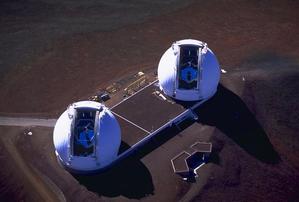Glossary term: Reflecting Telescope
Description: In a reflecting telescope or mirror telescope, the main optical element is a mirror, the "primary mirror", which gathers infalling light. Mirror telescopes are often characterized by primary mirror diameter, ranging from 10 centimeters for smaller amateur telescopes to eight meters for the largest solid mirrors used in professional telescopes. Still larger collecting areas can be obtained by combining several mirror segments, which then act in a way similar to that of a larger solid mirror. There are several types of mirror telescopes. For example, in a Newtonian telescope, the light coming from the primary mirror is reflected sideways by a smaller, flat mirror into an eyepiece or a camera. In a Cassegrain telescope, a smaller, convex secondary mirror reflects the light back through an opening in the main mirror.
Related Terms:
See this term in other languages
Term and definition status: This term and its definition have been approved by a research astronomer and a teacher
The OAE Multilingual Glossary is a project of the IAU Office of Astronomy for Education (OAE) in collaboration with the IAU Office of Astronomy Outreach (OAO). The terms and definitions were chosen, written and reviewed by a collective effort from the OAE, the OAE Centers and Nodes, the OAE National Astronomy Education Coordinators (NAECs) and other volunteers. You can find a full list of credits here. All glossary terms and their definitions are released under a Creative Commons CC BY-4.0 license and should be credited to "IAU OAE".
Related Media
Keck Telescopes
Credit: NASA/JPL credit link
License: PD Public Domain icons
Learning Nights
Credit: Juan Pablo Botero Londoño/IAU OAE (CC BY 4.0)
License: CC-BY-4.0 Creative Commons Attribution 4.0 International (CC BY 4.0) icons










